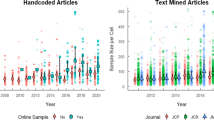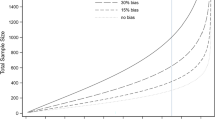Abstract
In this commentary, I propose a “big-picture” view of what good science is as a framework for evaluating scientific practices in consumer research. A big-picture view of science recognizes that scientific practices are not ends in themselves but tools to be used in the service of six epistemic ideals: veridicality, precision, transparency, generalizability, relevance, and insight. It is through a multidimensional contribution to these epistemic ideals that various scientific practices enable the production of evidence that is not only trustworthy but also useful. From this big-picture perspective, Krefeld-Schwalb and Scheibehenne’s results provide a decidedly mixed report card about the state of scientific practices in consumer research.

Similar content being viewed by others
Notes
As a caveat, it should be noted that the p-curve methodology has been criticized by McShane, Bockenholt, and Hansen (2016), who argue that the methodology is unreliable when the sample of studies is heterogeneous, as is the case in the KSS investigation. Simonsohn et al. (2014) maintain that p-curve analyses are valid even when samples are heterogeneous. However, this disagreement does materially qualify the general interpretation provided here.
See, for example, https://openmkt.org/research/replications-of-marketing-studies/
References
Bazerman, M. (2012). Keynote address. Society for Consumer Psychology Conference, Las Vegas, February, 18, 2012.
Ferber, R. (1977). Research by convenience. Journal of Consumer Research, 4(1), 57–58.
Goodman, J. K., & Paolacci, G. (2017). Crowdsourcing consumer research. Journal of Consumer Research, 44(1), 196–210.
Inman, J. J. (2012). The elephant not in the room: the need for useful, actionable insights in behavioral research. In Z. Gürhan-Canli, C. Otnes, & R. J. Zhu (Eds.), NA - Advances in Consumer Research, 40 (pp. 1–4). Association for Consumer Research.
Inman, J., Campbell, M. C., Kirmani, A., & Price, L. L. (2018). Our vision for the Journal of Consumer Research: it’s all about the consumer. Journal of Consumer Research, 44(5), 955–959. https://doi.org/10.1093/jcr/ucx123
Ioannidis, J. P. A. (2005). Why most published research findings are false. PLoS Medicine, 2(8), e124.
Jedidi, K., Schmitt, B. H., Sliman, M. B., & Li, Y. (2021). R2M index 1.0: Assessing the practical relevance of academic marketing articles. Journal of Marketing, 85(5), 22–41.
John, L. K., Loewenstein, G., & Prelec, D. (2012). Measuring the prevalence of questionable research practices with incentives for truth telling. Psychological Science, 23(5), 524–532.
Krefeld-Schwalb, A., & Scheibehenne, B. (2023). Tighter nets for smaller fishes? Mapping the development of statistical practices in consumer research between 2008 and 2020. Marketing Letters. https://doi.org/10.1007/s11002-022-09662-3
McShane, B. B., Böckenholt, U., & Hansen, K. T. (2016). Adjusting for publication bias in meta-analysis: An evaluation of selection methods and some cautionary notes. Perspectives on Psychological Science, 11(5), 730–749.
Nosek, B. A., et al. (2015). Promoting an open research culture. Science, 348(6242), 1422–1425.
Pechmann, C. C. (2014). Editorial regarding the new submission guidelines at the Journal of Consumer Psychology. Journal of Consumer Psychology, 24(1), 1–3. https://doi.org/10.1016/j.jcps.2013.10.002
Peer, E., Rothschild, D., Andrew, G., Evernden, Z., & Damer, E. (2022). Data quality of platforms and panels for online behavioral research. Behavior Research Methods, 54, 1643–1662.
Peterson, R. A., Albaum, G., & Beltramini, R. F. (1985). A meta-analysis of effect sizes in consumer behavior experiments. Journal of Consumer Research, 12(1), 97–103.
Pham, M. T. (2013). The seven sins of consumer psychology. Journal of Consumer Psychology, 23(4), 411–423.
Pham, Michel Tuan (2012), email to the Membership of the society for consumer psychology announcing the appointment of a taskforce on scientific practices, July 2012.
Pham, M. T., & Travis Tae, O. (2021a). Preregistration is neither sufficient nor necessary for good science. Journal of Consumer Psychology, 31(1), 163–176.
Pham, M. T., & Travis Tae, O. (2021b). On not confusing the tree of trustworthy statistics with the greater forest of good science: A comment on Simmons et al.’s perspective on pre-registration. Journal of Consumer Psychology, 31(1), 181–185.
Pham, Michel Tuan, Yinghao Alisa Wu, and Danqi Wang (2022), “Benchmarking consumer scholarship: a comparison of alternative metrics,” conditionally accepted at Journal of Consumer Research.
Preacher, K. J., & Hayes, A. F. (2008). Asymptotic and resampling strategies for assessing and comparing indirect effects in multiple mediator models. Behavior Research Methods, 40(3), 879–891.
Simmons, J. P., Nelson, L. D., & Simonsohn, U. (2011). False-positive psychology: Undisclosed flexibility in data collection and analysis allows presenting anything as significant. Psychological Science, 22(11), 1359–1366.
Simonsohn, U., Nelson, L. D., & Simmons, J. P. (2014). P-curve: A key to the file-drawer. Journal of Experimental Psychology: General, 143(2), 534.
Wells, W. D. (1993). Discovery-oriented consumer research. Journal of Consumer Research, 19(4), 489–504.
Author information
Authors and Affiliations
Corresponding author
Ethics declarations
Ethical approval
Not applicable.
Competing interest
The author declares no competing interests.
Additional information
Publisher’s note
Springer Nature remains neutral with regard to jurisdictional claims in published maps and institutional affiliations.
Rights and permissions
Springer Nature or its licensor (e.g. a society or other partner) holds exclusive rights to this article under a publishing agreement with the author(s) or other rightsholder(s); author self-archiving of the accepted manuscript version of this article is solely governed by the terms of such publishing agreement and applicable law.
About this article
Cite this article
Pham, M.T. Are scientific practices improving in consumer research? A glass half-full and half-empty. Mark Lett 34, 375–382 (2023). https://doi.org/10.1007/s11002-023-09679-2
Accepted:
Published:
Issue Date:
DOI: https://doi.org/10.1007/s11002-023-09679-2




